
views
Knowing the Essentials
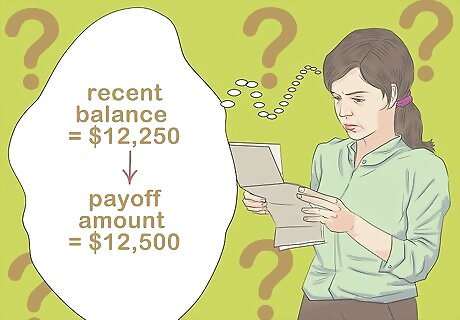
Understand why your mortgage payoff amount does not equal your current balance. Your statement says your most recent balance is $12,250, and yet your payoff amount (the amount it would take to close out the mortgage) is listed as $12,500. How can that be? You may assume that some complicated financial formulas are at play (ones that cost you money, of course), but in fact the answer is quite simple: mortgages are paid in arrears. That is, you pay June’s interest with July’s payment. This process starts at the beginning, at closing. If you close in June, for instance, your first payment won’t be due until August, with July’s interest included. Thus, to determine your payoff amount, the interest accrual since your last payment must be calculated and added to your balance. This interest wouldn’t typically be added to your balance until your next statement date.
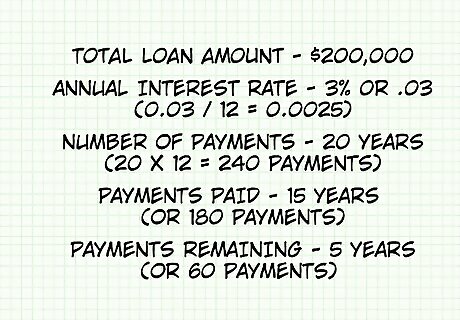
Gather the information needed for your calculations. In order to determine the payoff amount, either using a calculation program or on your own, you need to know a handful of basic figures regarding your mortgage. All of these figures should be available on your statement or other loan documents. These include: The total amount borrowed when you took out the loan (for example, $200,000). The annual interest rate (for example, 3%, or 0.03). To do the calculations yourself, you will need to divide this number by twelve (0.03 / 12 = 0.0025), because mortgage interest compounds monthly. The total number of payments for the life of the loan, which for monthly payments is the number of years times twelve (for example, 20 years = 240 payments). The total number of years / payments remaining, and the number paid so far (for example, 15 years = 180 payments made; 5 years = 60 payments remaining).

Consider online calculators if you’d rather not exercise your math muscles. The calculations aren’t all that complicated, but punching a few numbers in and pressing “calculate” is certainly easier. A search for “mortgage payoff calculator” will provide several useful results. Try out a few to ensure accuracy. Please note, however, that you may find slight variations in your final results, probably only a few cents, but enough that you should always confirm your payoff amount with your lender before attempting to make a final payment. Using two such online calculators for a $200,000 loan at 3% annual interest over 20 years, with five years remaining, produces payoff results of $61,729.26 and $61,729.33, respectively.

Contact your mortgage lender if you plan to make a final payment. Avoid making what you think is a mortgage payoff only to find out that you still owe a few dollars or cents that keeps your mortgage alive and accruing interest. Contact your lender by phone or online; lenders with online account management likely have a page that allows you to make the request. You will likely receive your payoff amount after a week. You will be asked to choose a specific date for which to determine the payoff. If you want to make the final payment, you will need to complete some version of payment form (online or by mail) with the precise amount due and the time frame in which this amount is valid as a final payoff. Such requests can be made solely for informational purposes as well. Some lenders may even include a payoff amount on your monthly statement.
Making the Calculations
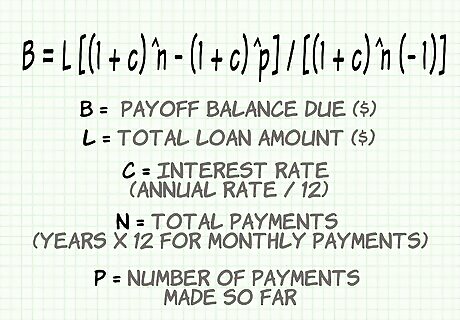
Lay out the formula carefully. It looks rather unwieldy at first, but the math is relatively straightforward once you’ve inserted your figures. Just be sure to copy the formula exactly or your results may vary significantly. The formula is: B = L [(1 + c)^n - (1 + c)^p] / [(1 + c)^n (- 1)] , in which: B = payoff balance due ($) L = total loan amount ($) c = interest rate (annual rate / 12) n = total payments (years x 12 for monthly payments) p = number of payments made so far
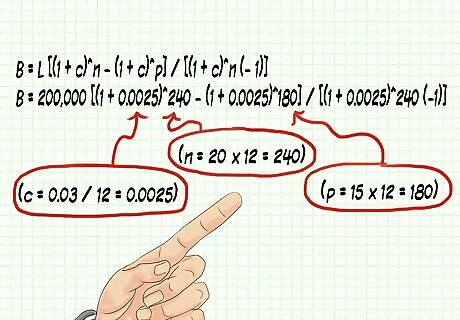
Insert your figures. Using the same example as for the online calculators, a 20-year, $200,000 mortgage at 3% interest with five years to go, appears thusly: B = 200,000 [(1 + 0.0025)^240 - (1 + 0.0025)^180] / [(1 + 0.0025)^240 (-1)] Remember that the 3% annual interest rate (0.03) is divided by twelve because it compounds monthly (c = 0.03 / 12 = 0.0025). Twenty years of monthly payments is 240 (n = 20 x 12 = 240), and fifteen years of payments so far is 180 (p = 15 x 12 = 180).
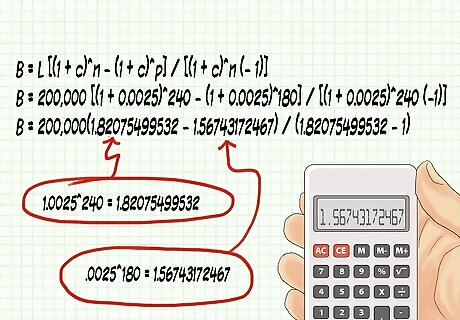
Power up your numbers. After adding 1 to 0.0025 the three times it appears in the formula, you will need to raise the resulting 1.0025 to the 240th power (twice) and to the 180th power (once). A good calculator will come in handy here. 1.0025^240 = 1.82075499532 1.0025^180 = 1.56743172467 B = 200,000(1.82075499532 - 1.56743172467) / (1.82075499532 - 1)
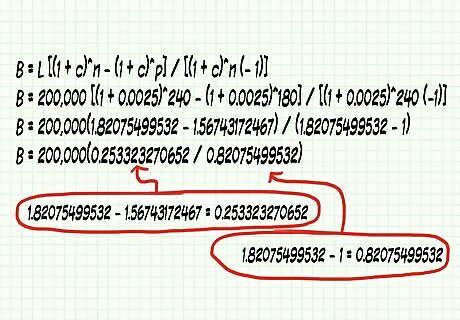
Subtract from the inside. Once you accomplish this step, the formula will appear much more manageable and will be that much closer to completion. 1.82075499532 - 1.56743172467 = 0.253323270652 1.82075499532 - 1 = 0.82075499532 B = 200,000(0.253323270652 / 0.82075499532)
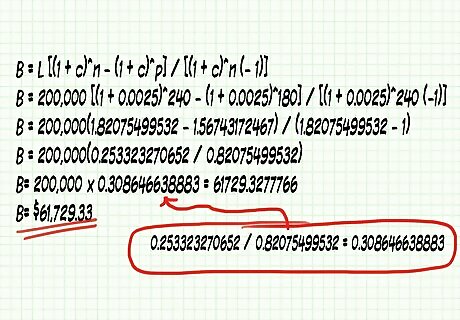
Divide, multiply, and conquer. Now you can finish things off and solve for B, your payoff amount. 0.253323270652 / 0.82075499532 = 0.308646638883 200,000 x 0.308646638883 = 61729.3277766 Therefore, your payoff amount is $61,729.33.

















Comments
0 comment